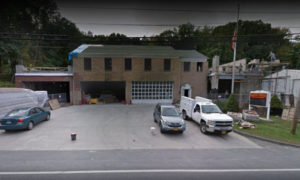 At 9 a.m. on February 25, 2014, the Goldens Bridge Fire Department’s fire house burned down. According to the State Police at the time, the fire was believed to have originated from a faulty electrical connection to a fire truck while parked inside of the firehouse. It took more than two and a half hours for crews to completely knock down the flames, and when the fire was out the damage was determined to have included not only the building but a $500,000 fire truck and two SUVs.
At 9 a.m. on February 25, 2014, the Goldens Bridge Fire Department’s fire house burned down. According to the State Police at the time, the fire was believed to have originated from a faulty electrical connection to a fire truck while parked inside of the firehouse. It took more than two and a half hours for crews to completely knock down the flames, and when the fire was out the damage was determined to have included not only the building but a $500,000 fire truck and two SUVs.
Three years later, after settling with the Goldens Bridge Fire District, its insurance company turned around and sued the Fire Department for reimbursement of the settlement payment, claiming that the fire was caused by the Department’s negligence when Department volunteers had done work on a Chevy Suburban, and was exacerbated when someone wedged open a fire door during training exercises, a move which allowed the blaze to move beyond the truck bays into the firehouse’s second floor.
The Goldens Bridge Fire Department is a New York not-for-profit corporation, established in 1909. As with most fire departments, it obtains most of its revenues from contributions. It is doubtful that the corporation has $9 million available to pay a damage award, if it were to come to that. In its 2015 Form 990, filed with the IRS and reported by GuideStar, the Department reported assets of $142,750.
This post does not discuss the merits of the case, which is pending in US Federal Court for the Southern District of New York. Rather, it asks, what happens if the Fire Department loses – what happens to the Fire Department, i.e., the corporate entity, and then who fights the fires?
If a Fire Department loses the lawsuit of great magnitude, and if the claim against the Fire Department is not covered by insurance, the Department could be subject to a judgment of many millions of dollars, which the plaintiff will most certainly seek to collect. I don’t see much that the Department, as a non-profit corporation, can do but shield itself by relying on U.S. bankruptcy laws.
Bankruptcy relief can be obtained by non-profit public-service entities such as volunteer fire companies. Those organizations can obtain relief from creditors and an opportunity to reorganize by a Chapter 11 bankruptcy. However, my research has uncovered only a few volunteer fire departments in the United States which have availed themselves of the U.S. bankruptcy laws.
In 2001, the Baggaley Volunteer Fire Department, in Pennsylvania, finding itself $241,000 in debt, simply shut down, with plans to declare bankruptcy. It stopped answering calls from 900 homes and 100 businesses in its service area.
In 2016, the Conneaut Lake Volunteer Fire Department, also in Pennsylvania, filed for bankruptcy protection when it faced a foreclosure action by a bank and other creditors. The filing caused an automatic stay, forcing all creditors to cease and desist from collection activities. The Fire Department continued to function normally and to provide fire protection during the bankruptcy.
So, what happens when a non-profit cannot meet its financial obligations? If it’s a volunteer fire department it should not just shut down, and leave the people in its service area without protection. The corporation can avail itself of the U.S. bankruptcy laws, and file for reorganization or insolvency. The corporation can still operate, and its executive officers, its line officers and its Board of Directors can continue to work toward the corporation’s stated purpose, which is not to maximize profits but to enable the corporation to carry out its stated purpose of fire prevention and firefighting.
The creditors of the non-profit corporation, unlike creditors of a for-profit corporation, cannot push the non-profit into bankruptcy by filing an involuntary bankruptcy petition against the non-profit. And they cannot compel the non-profit to convert its petition from Chapter 11 Reorganization to Chapter 7 Insolvency. Creditors cannot, in addition, receive the residual value of the insolvent non-profit corporation – the Board of Directors will generally retain control of the assets of the non-profit.
Ultimately, since a Fire Department has few tangible assets – other than its volunteers – and let’s assume it doesn’t have the resources to fight a multi-million dollar lawsuit or pay damages, a victorious claim by a plaintiff would be a Pyrrhic victory – one which inflicts such a devastating toll on the victor that it is tantamount to defeat, in this case because the victor spent a lot of money for a little return. The Department could, instead of defending the lawsuit or paying the judgment, file for bankruptcy, propose to reorganize its debts under supervision of the Bankruptcy Court, and continue to serve the community. Or, a new company could be formed – Fire Company No. 1 (the non-profit that got sued) could close its doors and Fire Company No. 2 could be formed, with the same volunteers but none of the debt, or of the assets.
Either way, it isn’t a good way to go, and it is a terrible cost for, if it is true, negligently causing a fire and allowing it to spread.

